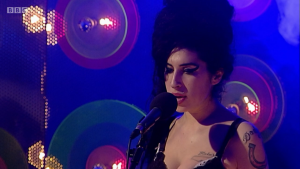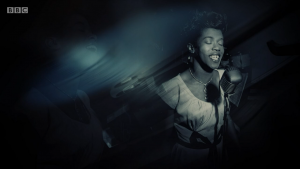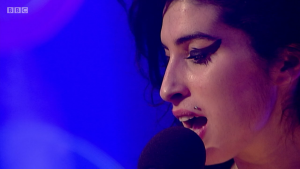by Leanne Weston, University of Warwick
The tenth anniversary of singer-songwriter Amy Winehouse's death on July 23, 2021, provided a natural point for reflection and reconsideration of her contribution to music culture, and how best to understand and honour that legacy. Once the subject of intense tabloid speculation, she has posthumously become an equal site of cultural fascination. This mythologising sparks several overlapping questions: What has become the marker of her cultural legacy? How do we interpret her as an artist? And, perhaps the most elusive: Who was the real Amy Winehouse?
The numerous media texts dedicated to her, whether written, photographic, audiovisual, or otherwise, have attempted to answer the what, how, and why of her life and death. These texts contribute to her cultural afterlife and maintain her posthumous stardom, and in markedly different ways, also contend with the competing facets of her star-image. On the one hand, this creates, as Bronwyn Polaschek persuasively argues, a ‘dissonance’ between Winehouse’s fractured public and private selves. (i) On the other, the complexity of that star-image has largely been stripped away. Her look has been flattened to the highly-reproducible iconography of her wing-tipped eyeliner and beehive. Her life story, meanwhile, has been reduced to dominant understandings of her as a “tragic” and “troubled” figure – a narrative cemented by the success of Asif Kapadia’s Amy (2015).

Title card of The Day She Came to Dingle.
The Arena film The Day She Came to Dingle (2012) is one origin point of a counter or alternate Winehouse narrative. (ii) It is part of a growing body of films that attempt to challenge our perception of Winehouse beyond the tragic. (iii) Dingle is explored here in relation to the contribution it makes to our understanding of Winehouse’s art and artistry, while also reflecting upon its position within Arena’s own cultural history. The film sought to reclaim, rewrite, and redefine her image in the popular consciousness and cultural memory, long before other texts, including Reclaiming Amy (2020), pursued similar ideas. In the intervening years since its first transmission, opinions and attitudes towards Winehouse, and understandings of substance abuse and mental health have improved significantly, highlighting the film’s cultural value and prescient care and attention to the treatment of its subject. As the BBC press release boldly states: ‘The programme is about the music, not the madness. And that’s how it should be.’ (iv) A neat summation of the film’s central thesis, its power has only increased with time.
Directed by Maurice Linnane, Dingle is exemplary of Arena’s past and its present. It illustrates, through its humanist engagement with an artist and their art, the cultural work that informs Arena’s long broadcast history and its impact on arts programming. Appearing in series 37, it was preceded by a documentary on theatre and opera director Sir Jonathan Miller, and followed by a two-part special revisiting The Beatles’ Magical Mystery Tour. Dingle is testament to the wide-range of art forms Arena has engaged with throughout its lifetime, and more specifically, its dedication towards the exploration of music as a form of creative and emotional labour. It is also concerned with an artistic return, dedicated to Winehouse’s appearance on Irish music programme, Other Voices (RTÉ, 2003 –).
Unlike many of the later documentaries on Winehouse, Dingle is not, as Hannah Andrews fittingly describes in relation to Amy, an ‘audiovisual post-mortem’, but rather, an artistic meditation that takes us back in time and returns Winehouse to us, simultaneously a celebration of her artistic merits and the Other Voices stage. (v) The implications of this difference in approach are clear from the film’s atmospheric opening moments, showing an empty beach. Here, a metanarrative concerned with journeys is established, existing across two intersecting temporalities: 2006 and 2012. Over the course of the film, Dingle constructs and reconstructs these two time periods, allowing them to intertwine by existing in the same space.
The first journey is physical and geographical, one detailing Winehouse’s physical journey to the Dingle Peninsula. Initially told through intertitles, a 22-year-old Winehouse’s arrival in Dingle is described as ‘a world away from the North London she grew up in.’ Later, this is relayed through first-hand experience, when local taxi driver Paddy Kennedy tells us of Winehouse’s journey from the airport to St. James’ Church on a stormy night. Through this, Dingle is rendered othered and otherworldly – a place with its own unique mythos. These qualities are reiterated in the comments of series editor Philip King who calls it ‘the edge of the known world.’ Later, he comments that the journey requires ‘commitment’ from artists to complete, summarising that ‘Something really special happened the day Amy came to Dingle.’
The second journey, reflected by the film’s composite construction of archive, performance and interview footage, is creative, and metaphorical – the journey to reflect upon and rediscover Winehouse’s music. Central to the effectiveness and the affectiveness of the film is the editorial decision to recentre the narrative on Winehouse herself, allowing her to, as Philip King puts it, ‘tell the story of her music in her own words.’ Dingle reauthors her narrative through its creative and cultural intervention, lending Winehouse the agency she often lacked in life. Moreover, through its process of reclamation, Dingle also prefigures more recent popular reappraisals of her work(vi). In Dingle, this is entirely filtered through the prism of Winehouse’s own knowledge and understanding of her relationship to music culture, and its impact upon her creative process.

Winehouse performing ‘Tears Dry On Their Own.’
Winehouse’s original Other Voices appearance was recorded at St. James’ Church in December 2006. The archival material of that performance and interview with then presenter John Kelly are recontextualised, intercut with contributor interviews, featuring Philip King, and series music producer Aoife Woodlock, alongside Winehouse’s bass player, Dale Davis, amongst others. The reframing of Winehouse’s life and work through the lens of Arena allows the series to function as a ‘cultural intermediary,’ that both produces cultural history, and rewrites it; whether through shedding light on lost art and artists, or, as in Dingle, challenging the information already circulating in the public domain. (vii)
Through remediation, Dingle becomes a cultural palimpsest, one that overwrites our original experience(s) of Other Voices, creating a space where the distance between the past and the film’s present are bridged, simultaneously bound to the context of their original recording, and yet unbound, existing somewhere other, in a fittingly otherworldly space. What does it mean for us to re-encounter Winehouse in this different, but familiar context? The audience cannot fail to know or understand that these segments are pieces of archive footage, and yet, it does not always feel that way when watching. Winehouse feels present, alive, and this feeling does not diminish whether watching Dingle in 2012 or 2022. This is perhaps because the footage from 2006 lacks any aesthetic markers of age – grain, colour, and so on – with any temporal references limited to Winehouse’s physical appearance or names and dates she refers to in conversation.
The strangeness or otherworldliness generated by these textual re-encounters are, as William Urrichio argues, part of television’s own temporality.’ (viii) However, Dingle and the other texts which re-use archive footage present an intriguing contradiction. While emblematic of the conditions Urrichio describes, Dingle represents a changed relationship to how we experience televisual time. In her work on the creative uses of archive, Vana Goblot describes this as a ‘distortion’ created by the space between lived experience and mediated memory. For Goblot, this distortion ‘changes the possibilities of the “fixity” of a television programme in the time it was made.’(ix) When viewed with this lens, Dingle is a site of memory work that exists at the intersection between public memorialising and private recollection, whose relationship to and with memory exemplifies the lack of ‘fixity’ Goblot describes. Equally relevant here are Allison Landsberg’s observations in Engaging the Past, concerning the production of historical knowledge and our engagement with history. According to Landsberg, this relationship is defined by ‘the popular desire to bring things close,’ analogous to Misha Kavka’s work on television as ‘technology of intimacy.’(x)
![Winehouse during interview with Other Voices presenter John Kelly [off screen].](https://learningonscreen.ac.uk/wp-content/uploads/2022/06/VF-Winehouse-F3-300x169.png)
Winehouse during interview with Other Voices presenter John Kelly [off screen].
The discussion between Kelly and Winehouse is where the film becomes most distinctive and insightful. It is also where we become, as Landsberg and Kavka would have it, close to Winehouse or more accurately, she is brought close to us once more. (xi) It is no coincidence that the first sound we hear after the sea is Winehouse’s voice, singing ‘Back to Black.’ This editorial choice sets up the importance of her voice, her words, and her music to the film as a whole. The interview segments between Kelly and Winehouse also allow us to see and hear the depth of her musical knowledge, and how these diverse influences – ranging from Mahalia Jackson and Sarah Vaughan to Ray Charles and Soweto Kinch – are reflected in her songwriting, lyrics, and musical style. These segments also function as a counterpoint to the tabloid focus on Winehouse’s personal life and substance abuse, which, at times, overshadowed her accomplishments as an artist. Dingle is also therefore corrective, reinstating and reclaiming her value as a musician.
Pivotal to these sequences is the discussion and representation of jazz, regularly featured as part of the Arena output, whether in biographies, films on jazz culture or other histories. (xii) In Dingle, jazz is intertwined into the wider history of Winehouse’s engagement with, and love of, jazz culture. Throughout, she reflects on the transformative effects of listening to jazz, namely Thelonious Monk, her early years as part of the National Youth Jazz Orchestra, and later singing as part of a duo in intimate gigs, much like the one she delivered for Other Voices. The discussion is leant visual dynamism through an aesthetic akin to an audiovisual scrapbook, shown onscreen. Archival performance footage of Jackson, Monk or Charles for example, is overlaid with other audio and/or photographs. A spinning vinyl record is also usually visible, underlining that not only does music have physical, tangible traces, but it is also a product with its own intrinsic creative, and as Winehouse observes, emotional value.

The scrapbook aesthetics of musical inspirations featuring Sarah Vaughn
As Kelly and Winehouse discuss her gradual shift from the jazz-infused sound of her debut album Frank, to the “poppier” sounds of Motown girl groups of the 1960s which influenced its follow-up, Back to Black, Winehouse relates her love for melodrama of the Shangri-las ‘I Can Never Go Home Anymore’ (1966). She describes it as ‘the saddest song in the world,’ candidly offering that she listened on repeat while drinking as a coping-mechanism for a break-up. A clip of the song follows, and once more, a spinning vinyl record illustrates it. The song’s lyrics are displayed on screen, stylised like a karaoke video, complete with bouncing ball. An amused Kelly cues Winehouse to recite a lyric from memory: ‘She grew so lonely in the end/Angels picked her for their friend’, after which, she reiterates the depressing and sad nature of the song. The gravity of the moment is however, undercut by her self-deprecating humour. (xiii) In retrospect, it remains an undeniably poignant moment, particularly given the nature of Winehouse’s death, but its appearance in the new context of Dingle does not feel mawkish. Rather, it captures a snapshot of Winehouse’s state of mind, emphasising the autobiographical nature of her songwriting(xiv). Here, momentarily, the past and the present collide, breaking the illusion of Winehouse’s continued presence.

The karaoke styling of The Shangri-Las ‘I Can Never Go Home Anymore.’
The end of this sequence also signals a change in the film’s tone, toward the sorrowful rather than outright tragic, as Dingle gradually shifts to address the impact of Winehouse’s death. While the tragedy of her loss is acknowledged, Dingle repeatedly illustrates that there is much more to Winehouse than this entrenched association. Avoiding both sentimentality and salaciousness, the discussion of it remains thoughtful and reflective. This section of the film begins with Reverend Máirt Hanley discussing the mythos of the struggling artist. Considering Winehouse in this context, he notes that listening to her music now is ‘tinged with a touch of sadness.’ Hanley’s words recall those of Stephanie Zacharek on the affective experience of listening to Winehouse’s music after her death:
When a musician or singer we love dies, we mourn with our ears. Once an artist is lost to us, the music he or she has left behind somehow changes color and tone, often becoming more beautiful rather than less — maybe because what we’re hearing is a beginning with an ending already written into it. (xv)
Just like the pained protagonist of The Shangri-Las song whose mother died from grief; we too know the ending of Winehouse’s story. To follow from Zacharek, our experience of Dingle is similarly coloured by this knowledge. The film’s presentation of Winehouse and her death is also informed by that same knowledge. Her death is not explicitly addressed until 54 minutes into the film when Davis is asked directly if he misses her. He replies yes, and the question prompts him to reflect further on the personal impact and enormity of her loss.

Winehouse performing ‘Me and Mr Jones.’
The final moments of the film, bracketed by a performance of ‘Me and Mr Jones’ prompts us to consider what is implicit within Davis’ words: What is left behind? What happens when we go back and look at all that remains as Dingle naturally encourages us to do? What does legacy mean and what does it look like? In 59 mins and 34 seconds, The Day She Came to Dingle provides us with potential answers. The film presents these through a greater understanding of Winehouse’s creative process, and by offering reflections on her contribution to music culture. As Philip King’s closing comments remind us: ‘When Amy Winehouse sang, she let us in, if we have the ears to hear and the eyes to see into the heart of what she really was as a person and as an artist.’
There remains one question, to which there is no definitive answer: Who was the real Amy Winehouse? Perhaps never knowing will ensure we are perpetually drawn to her, compelled to revisit her work. Ultimately, the lack of definition does not matter, because in the end, all that really does matter is the music.
About the Author
Leanne Weston is currently an IAS Early Career Fellow at Warwick. Her doctoral research on music programming, memory, and materiality in post-broadcast screen culture forms part of ongoing work in the Centre for Television Histories. Leanne has published work in Velvet Light Trap on televised music histories, and has recently co-edited a dossier on BBC Four for Critical Studies in Television. She is a contributor to forthcoming edited collections on Watership Down (Bloomsbury Academic) and the films of Jane Campion (Edinburgh University Press), writing on the function and meaning of film scoring. She is co-convenor of the BAFTSS Performance and Stardom Special Interest Group.
Bibliography
(i) Polaschek, Bronwyn. ‘The Dissonant Personas of a Female Celebrity: Amy and the Public Self of Amy Winehouse’. Celebrity Studies, vol. 9, no. 1, Jan. 2018, pp. 17–33, https://doi.org/10.1080/19392397.2017.1321490.
(ii) First tx. 23.07.12, BBC Four, 10 pm. The film was rebroadcast on the tenth anniversary of Winehouse’s death in 2021, alongside of Amy Winehouse in Her Own Words (2015) and Classic Albums: Amy Winehouse Back to Black (2018).
(iii) Notably, the word ‘tragedy’ is not used until over 38 minutes into the film, when Philip King states that Winehouse’s ‘brilliant career ended in tragedy.’ King’s use of the word ‘career’ over ‘life’ is a significant one that places emphasis on her creative output and its legacy in line with the film’s overall thesis.
(iv) BBC Media Centre. Arena: Amy Winehouse - The Day She Came To Dingle. 2012, https://www.bbc.co.uk/mediacentre/proginfo/2012/30/amy-winehouse
(v) Andrews, Hannah. ‘From Unwilling Celebrity to Authored Icon: Reading Amy (Kapadia, 2015)’. Celebrity Studies, vol. 8, no. 2, Apr. 2017, https://doi.org/10.1080/19392397.2017.1311634, p. 351.
(vi) See, for example, Fearon, Faye. ‘The Hidden Gems in Amy Winehouse’s Discography’. British GQ, 23 July 2020, https://www.gq-magazine.co.uk/music/article/amy-winehouse-best-songs.
(vii) Smith Maguire, Jennifer, and Julian Matthews, editors. The Cultural Intermediaries Reader. Sage, 2014.
(viii) Urrichio, William. ‘TV as Time Machine: Television’s Changing Heterochronic Regimes and the Production of History’. Relocating Television: Television in the Digital Context, edited by Jostein Gripsrud, Routledge, 2010, p. 27.
(ix) Goblot, Vana. ‘The Television Archive on BBC Four: From Preservation to Production’. VIEW: Journal of European Television History and Culture, vol. 4, no. 8, Dec. 2015, p. 87, https://viewjournal.eu/articles/10.18146/2213-0969.2015.jethc095/.
(x) Landsberg, Alison. Engaging the Past: Mass Culture and the Production of Historical Knowledge. Columbia University Press, 2015, p. 22; Kavka, Misha. Reality Television, Affect and Intimacy: Reality Matters. Palgrave Macmillan, 2008, p.5.
(xi) I explore these ideas in relation to mediated returns focussing on David Bowe and Amy Winehouse in ‘Live Forever: Glastonbury 2020, Television, Time, Memory, and Nostalgia’. CST Online, 25 Sept. 2020, https://cstonline.net/live-forever-glastonbury-2020-television-time-memory-and-nostalgia-by-leanne-weston/.
(xii) For further discussion on Arena’s representation of jazz see Finch, Will. ‘Material and Expositional Frames in BBC Arena’s Visual Jazz Jukebox’. Jazz Research Journal, vol. 12, no. 1, 2018, pp. 110–37.
(xiii) Winehouse recites the lyrics as follows: ‘She grew so lonely in the end/the angels came and took her for their friend.’
(xiv) The influence of The Shangri-Las record, and the break-up to which she refers are evident musically and in ‘You Know I’m No Good’ and its accompanying video directed by Phil Griffin.
(xv) Zacharek, Stephanie. ‘We Could Only Hold Her for so Long: Stellar Doc “Amy” Summons up All That Amy Winehouse Was’. The Village Voice, 30 June 2015, https://www.villagevoice.com/2015/06/30/we-could-only-hold-her-for-so-long-stellar-doc-amy-summons-up-all-that-amy-winehouse-was/